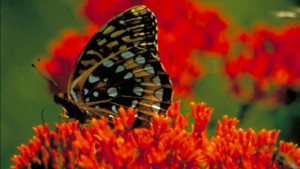Source: mnn.com
Published: May 22, 2013
Kids can help scientists understand the impact of climate change on butterflies by sharing their butterfly sightings in a new database.

Photo: FWS.gov
School is almost out, which means that in the next few weeks, many kids will find themselves with lots of free time on their hands. A new project, called eButterfly, is hoping to tap into this free time by teaching kids how to become citizen scientists who can help build a database of butterfly sightings around North America.
The project, which is now online at e-butterfly.org, will allow everyone from children to senior citizens to record the butterflies they see or collect, build a virtual butterfly collection, share their sightings with others, and contribute to a scientific record of global change.
Scientists know that butterflies are extremely sensitive to changes in temperature, population growth, urban sprawl, changes in land and water use, and many other forces. Experts have the ability to interpret these changes with computers and better understand how they are affecting biodiversity – but they don’t have the human power to gather all the data. “What we need, and what we believe eButterfly will provide, is thousands of individuals collecting data on butterfly sightings all over the U.S. and Canada, for decades to come,” said Katy Prudic, a research scientist at Oregon State University and founder and director of this project in the U.S.
Because the project taps into the natural interests of children, both rural and urban, who have been chasing butterflies and making collections for centuries, it also offers an entry into the world of science at a very young age, organizers say. Their contributions will be just as valuable as those of an adult hobbyist or working professional, and in the process they can learn about ecology, botany, entomology, geography, computers, data management and the effects of climate change.
The new website offers a tutorial in how to use it, and simple features such as a map that you can zoom in on, to provide exact latitude and longitudes of butterfly sightings. Experts will review entries for accuracy, and people will be encouraged to take digital photos to help verify their sightings. It’s free, and all you need to get started are a sharp eye, an interest in nature and a computer.
Data from new sightings will be combined in this project with historical information from a century of museum collections, organizers say, to provide some historic perspective almost immediately.
